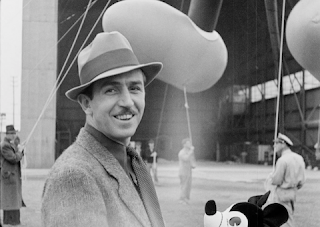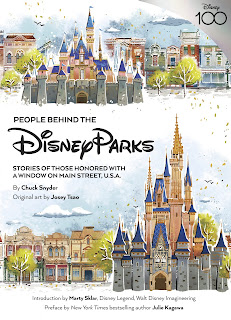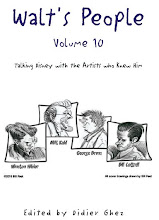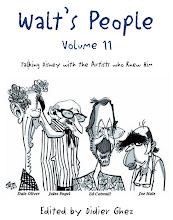Thursday, December 28, 2023
Tuesday, December 12, 2023
I suspect that one of you picked up those exceptional documents pertaining to Bill Tytla in the the auction by Heritage this weekend.
If that is the case, could you please, please email me at didier.ghez@gmail.com? I would love to get access to some of the info they contain and have some incentives that you may like to motivate you. Thanks in advance.
Monday, December 11, 2023
Ken Bruce's spectacular new book about Walt Disney's Enchanted Tiki Room, Before the Birds Sang Words, had just been released and it is a great read and a must-have. My only regret is the lack of endnotes, but not all books can be perfect. This one is like Mary Poppins: "almost perfect in every way."
Wednesday, November 29, 2023
I have not yet watched "Wish" but I just got the book The Art of Wish and I absolutely love it.
First, there is a lot more text than in previous installments of "The Art of" series, and then there is the stunning concept artwork by Lisa Keene (who never ceases to stun me), Camille Andre, Griselda Sastrawinata-Lemay and many more immensely talented concept artists.
I hope the movie is as good as the art book.
Tuesday, November 28, 2023
Quick a few astounding treasures in the upcoming auction by Heritage in a few days, including this stunning piece by Gustaf Tenggren, which I had the pleasure of seeing in person for the first time about 10 years ago at the house of Eric Gurney's son.
Thursday, November 09, 2023
Monday, November 06, 2023
Thursday, November 02, 2023
Wednesday, November 01, 2023
Tuesday, October 31, 2023
Saturday, October 28, 2023
Thursday, October 19, 2023
UCLA's Film and Television Archive has just released some astounding Disney-related footage thanks to Randy Yantek. You can watch all of it as this link. Enjoy!
Tuesday, October 17, 2023
Monday, October 16, 2023
FINALLY!
I am glad to report that Disney enthusiasts in Europe can now purchase The Origins of Walt Disney's True-Life Adventures via a local European distributor. Here is the link.
By the way, this monograph is one of the finalists for this year's Theatre Library Association Award.
Saturday, October 14, 2023
Several readers who own this book have sent me messages underlying the fact that I missed the point of the book in my review. It is also great for adults who want to learn how to draw Disney characters. I am guilty as charged. Not being able to draw at all myself, I did indeed miss that point.
I agree with all those who mentioned this: It is indeed also a great book for adults.
Friday, October 13, 2023
Are you looking for the perfect Christmas gift for kids who would love to learn how to draw Disney characters and learn a bit of Disney history as well?
Then this wonderful new book by my friends Jim Fanning and Andreas Deja is the perfect answer to your challenge.
This is not a book for grown-up historians, but it is the perfect way to introduce a kid or a teenager to some elements of Disney history, while giving them the tools to start their artistic careers.
And of course, it goes all the way from the 1920s to the 2020s, which I loved. I wish this book had been released in the 1970s, when I was a kid!
Saturday, October 07, 2023
Paging through it I learned that the Dutch magazine from the late 1930s, Olijk en Vrolijk, had featured a few Disney covers. See below.
Monday, October 02, 2023
Friday, September 29, 2023
A few days ago, I had the pleasure of interviewing Greg Glasgow and Kathryn Mayer, authors of the newly released Disneyland on the Mountain. Enjoy!
Didier Ghez: Why, how and when did you decide to write Disneyland on the Mountain?
We are both Disney fans who had heard a bit about Mineral King over the years, but when we visited the Walt Disney Family Museum in 2018, we saw the project mentioned on the museum’s extensive timeline of Walt’s life. What really piqued our interest was that the mention included the fact that Walt’s partner on the project was Willy Schaeffler, a well-known Colorado skier and head ski coach at the University of Denver in the 1960s and 1970s. We were familiar with Willy since Kathryn is a graduate of DU, and we actually met working at the school. That inspired us to look more into the story, and we quickly realized how much there was to it. We were shocked to learn how extensive the story was—from the environmental movement that was taking off at the time to Walt’s death in the middle of the planning for Mineral King and the battle going to the Supreme Court.
DG: Two books have already been released about the Mineral King project, Mineral King: Public Concern with Government Policy by John Harper, in 1982, and, more recently Dawn at Mineral King Valley: The Sierra Club, the Disney Company, and the Rise of Environmental Law by Daniel Selmi. What makes your new book different?
Thanks for asking this question! Both of those books are great, and they were helpful resources for us as we wrote ours, but we really tried to set ours apart. Harper’s self-published book came out in 1982, as you mentioned, and is more or less his chronicle of his experience, as a Sierra Club member, fighting against the Disney development. Selmi, similarly, is a legal scholar and professor who did a great job writing about the legal aspects of the Sierra Club v. Morton case and its impact on environmental law. We were writing ours at the same time as Selmi was writing his, and his came out about a year before ours. We were glad after reading his, though, that his book turned out very different from ours.
In Disneyland on the Mountain, our goal was to tell both sides of the story—the Disney side and the environmentalist side—and to give equal weight to both. We also strived to do it in a very narrative way, with characters and dialogue, to make it a hopefully enjoyable and engaging read.
DG: What were the most important new sources of information that you got access to?
We were able to talk to many people on the Disney and the environmentalist side of this battle, including Michael McCloskey, who was the leader of the Sierra Club during the Mineral King fight, and Jean Koch, a Mineral King cabin owner who was a very vocal opponent of the development and who donated all of her Mineral King materials—newspaper articles, legal documents, letters, maps, etc.—to the University of Southern California. We visited that archive for a few days early on in our research.
On the Disney side, we talked with former employees including Frank Allnutt and Frank Stanek, as well as the descendants of several Disney people who were involved with the Mineral King project.
We also tracked down other archival documents, old Disney reports, and letters, among other resources.
DG: What were the most interesting discoveries that you made in the course of your research?
Most interesting to us were Walt’s experiences at the 1960 Winter Olympics, and the fact that he was such a dedicated and award-winning conservationist. We also had no idea, when we started our research, that the Mineral King battle lasted nearly two decades and involved a legal case that went all the way to the Supreme Court.
DG: What were the most challenging aspects of this book project?
As you would imagine,
the most challenging part was doing all the research and tracking down people
to talk to. Most of our interviews came from simply finding people online and
reaching out to see if they would talk to us (sometimes they would point us in
the direction of another source). And as you’ll see from our endnotes, our
research involved numerous sources, including newspaper and magazine articles,
Disney annual reports, book chapters, meeting minutes, government documents,
documentary films, and more. It was a lot to go through!
DG: Are you planning to write more Disney-related books?
We would love to! We are big Disney people and are so fascinated by the company’s rich history. We are starting to work on our next project now, and while it’s too early to divulge details, it is in a somewhat similar vein to Disneyland on the Mountain.
Wednesday, September 27, 2023
I have been waiting and waiting for this book for years and years.
If, like me, you are curious to know who the men and women who are featured on the windows of Main Street are, this book is definitely for you.
Chuck Snyder has written the definite guide to the Main Street windows, complete with photos of all the people featured in the book.
This is a critically important volume and a must-have for Disney historians.
Tuesday, September 26, 2023
I love "The Nightmare Before Christmas" and can't get enough when it comes to the history of the making of the movie.
Which is why I am so delighted to have received a copy of Dave Bossert's gorgeous new book on the subject.
Based on new interviews and extensive research, this is a must-have.
By the way, this is really a great year for Dave. First his "House of the Future" masterpiece and now this.
Congratulations!
Monday, September 25, 2023
Sunday, September 24, 2023
I wrote the foreword for Jamie Hecker's new book which has just been released yesterday. You can read it below:
[As a teenager growing up in the 1980s, I was already passionate about Disney history.
As soon as I managed to learn enough English to allow me to do, I sought out American magazines which contained good, accessible books and articles about Disney history. Two of the writers whose work I loved were Jim Korkis and Jim Fanning. My understanding of Disney history did not yet run very deep and I needed historians to gently guide me in this gigantic maze of stories about Disney artists and their creations. In other words, the two Jims provided well-written, entry-level pieces about the men and women who made Disney “Disney” and about their fascinating creations.
Thanks to them I discovered who was who, how their operated and how they collaborated. I also learned much more about their boss, the great Walt Disney. The two Jims took me by the hand and helped me understand the big picture, which, years later meant that I was able to dig much deeper and to finally become an actual Disney historian. Without them and without their work, I would never have acquired the fundamental Disney history knowledge that would one day allow me to write Disneyland Paris—From Sketch to Reality, Disney’s Grand Tour, The Origins of Walt Disney’s True-Life Adventures or the They Drew as They Pleased—The Hidden Art of Disney art book series.
It is therefore with delight that I discovered the work of Jamie Hecker in the pages of the magazine Celebrations. His profiles of Disney Legends go beyond the short biographies released on the D23 website but are short enough to provide great introductions to the lives and work of these exceptional artists for readers who love Disney history but have yet to become Disney history specialists.
Like Jim Korkis’ and Jim Fanning’s pieces, Jamie’s articles are well-written, well-researched and a joy to read.
It is therefore with enthusiasm that I see some of them collected in this first volume of what I hope will become a long book series.
One, which, I suspect, will inspire quite a few teenagers to one day become Disney historians.
Didier
Ghez
Coral
Gables, August 2023]
Thursday, September 21, 2023
I am excited to announce that a new volume of Walt’s People has just been released today.
Walt’s People: Volume 28 features appearances by about Mike Bagnall, Richard Berryman, Ray Bradbury, Bill Cottrell, Roy E. Disney, John Drury, Nick England, Don Escen, Al Eugster, Leigh Harline, Dan Haskett, John Hench, Grace Hurt, Brandon Kleyla, Rich Kullen, Fred MacMurray, Mel Powell, Woolie Reiterman, Jim Sarno, John Tobin, and Ray Watson.
Tuesday, September 19, 2023
In Groningen, I met with Jan-Willem de Vries. I had both the Dutch and English versions of his biography of Disney comic artist Daan Jippes and loved it.
What I did not know is that Jan-Willem has also written quite a few artbooks about the history of the Dutch animation and comic studio Toonder. Those are not Disney-related but they are so beautiful and so impressive that I have to show some of them here.
If you speak Dutch (or are willing to read those heavily-illustrated books using Google Translate) those books are well-worth buying if you can find copies. I cannot say enough good things about them.
Friday, August 18, 2023
VOLUNTEER NEEDED IN CONNECTICUT
I just realized that, as far as I know, no in-depth research has been conducted about the animated sequences that the Disney Studios produced for Frank Capra's "Why We Fight" series.
I suspect that some relevant material might be preserved in the Frank Capra Archives at Wesleyan University in Middletown, Connecticut and I wonder if one of you would be willing to go there to conduct some research under my guidance.
If so, could you please email me at didier.ghez@gmail.com?
Friday, August 04, 2023
Friday, July 28, 2023
Right before he passed away, Jim Korkis wrote the following:
[James (“Jim”) Patrick Korkis was born August 15, 1950, in Tulsa, Oklahoma. He passed away at the age of 72 of stage four colon on July 28, 2023. He is survived by his two brothers Michael and Chris. Jim was divorced and had no children.
When
he was five years old his family moved to Glendale, California where Jim grew
up attending Edison Elementary School (where one of the teachers was Mrs.
Disney, the wife of Walt’s older brother Herbert), Roosevelt Junior High,
Hoover High, Glendale Junior College and Occidental College where he graduated
with a Bachelor’s degree and Master’s Degree with a major in English and a
minor in Theater Arts. After graduation he spent two decades teaching English
and Drama at Huntington Middle School in San Marino, California. Jim helped pay
his way through college by working at the Los Angeles Zoo as a driver and tour
guide.
Jim
was known as a comics historian writing a column of comics trivia for Amazing
Heroes as well as articles for Comic Book Marketplace, Comics
Artist and more. He was a vendor at the San Diego ComicCon for several years
with the company he co-owned, Korkis and Cawley's Cartoon and Comic Company. He
wrote introductions of over three dozen Malibu Graphics collections of vintage
comic strips and comic books.
Jim
was known as an animation historian who wrote long-running columns for Animation
Magazine, Animato!, Animania, Comic Journal, and more.
For the last ten years he wrote a weekly column for www.cartoonresearch.com.
With writing partner John Cawley he co-wrote four books about animation like Cartoon
Confidential.
In
California, Jim also pursued a career in theater. He appeared in over 100
theatrical productions, starting with Glendale Center Theater. He directed over
100 stage performances. He did some occasional voice over work.
With
his brothers, Jim appeared at The Gong Show, The Dating Game and Family Feud. By
himself he appeared on Camouflage (where he won a Cadillac) and the pilot
Origins. He appeared on Entertainment Tonight as a Disney historian.
With
his brother Mike, Jim developed a comedy magic act as part of a show he wrote
and directed at Six Flags Magic Mountain Lucky Louies Roaring ‘20s Revue. They
performed at the Variety Arts Theater, Johnathan Clubs, J.C. Penny and more.
Jim was a performer in Pelican’s Corner at Magic Mountain and helped design the
Halloween Haunted Mountain promotion.
In
1995 he moved to Orlando, Florida to take care of his ailing mom and dad. Jim
became identified as a Disney historian and worked as a performer (Merlin in
the Sword in the Stone ceremony and Prospector Pat in Frontierland), an
animation instructor at The Disney Institute, Guest Relations at Epcot, tour instructor
with Disney Adult Discoveries, and coordinator with The Disney Learning Center.
He was brought as a special consultant for Disney Cruise Line, Disney Vacation
Club, Imagineering and Animation (where he taught different classes for
interns) among other departments.
Disney
laid off Jim in 2009 along with thousands of others. Jim started writing books
about all things Disney and ended up producing over three dozen books. He was a
popular guest on podcasts.
Wednesday, July 26, 2023
VOLUNTEER NEEDED NEAR UC, BERKELEY
Yesterday, I stumbled upon this paragraph in a report from a Mr. Alan Cranston to a Mr. Elmer Davis. At the time Cranston was chief,foreign language division, Office of War Information. He later became a senator.
I wonder what happened of this project and if Cranston interacted even more with the Disney Studios. I suspect he did.
To find out, one would have to dig into Cartons 3 and 4 (Subseries 1.3 -- Office of War Information 1942-1944) in the Alan Cranston Papers, 1914-1993 (BANC MSS 88/214 c) which are preserved at The Bancroft Library at the University of California, Berkeley.
Would one of you be willing to volunteer to do so? If so, could you please email me at didier.ghez@gmail.com?







































































